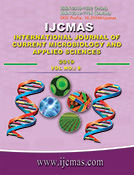


 National Academy of Agricultural Sciences (NAAS)
National Academy of Agricultural Sciences (NAAS)

|
PRINT ISSN : 2319-7692
Online ISSN : 2319-7706 Issues : 12 per year Publisher : Excellent Publishers Email : editorijcmas@gmail.com / submit@ijcmas.com Editor-in-chief: Dr.M.Prakash Index Copernicus ICV 2018: 95.39 NAAS RATING 2020: 5.38 |
Aim of the study is to isolate and enumerate dermatophytes and other fungi from clinically suspected cases of Dermatomycoses, to co-relate the isolate and findings with clinical presentations and to analyse the Dermatophyte test medium for the growth of dermatophytes. Hundred (100) clinically suspected cases of dermatophytosis and dermatomycoses attending Dermatology O.P.D., was selected for the study including hair, skin and nail samples. It was a prospective and descriptive study. Direct microscopy was performed using KOH (10 and 20%) and culture performed using Sabourauds dextrose agar (SDA), Dermatophyte test medium (DTM) and Corn meal agar. Data analysis was made on SPSS version 20, using chi-square test. The p value of 0.05 or less was considered significant. The highest age incidence was age group 21 – 30 years. Tinea unguium (68%) was the commonest clinical type followed by Tinea corporis (13%). KOH was positive in 60(60%) cases and culture positivity in 45(45%) cases. Trichophyton mentagrophyte (28.9%, 13/45) was the commonest dermatophyte isolated. Among the non-dermatophyte, Candida albicans (17.8%, 8/45) was the commonest isolate, followed by Candida tropicalis (15.6%, 7/45) and Candida parapsilosis (13.3%, 6/45). DTM was not a good medium for primary isolation of dermatophytes in our study.
 |
 |
 |
 |
 |